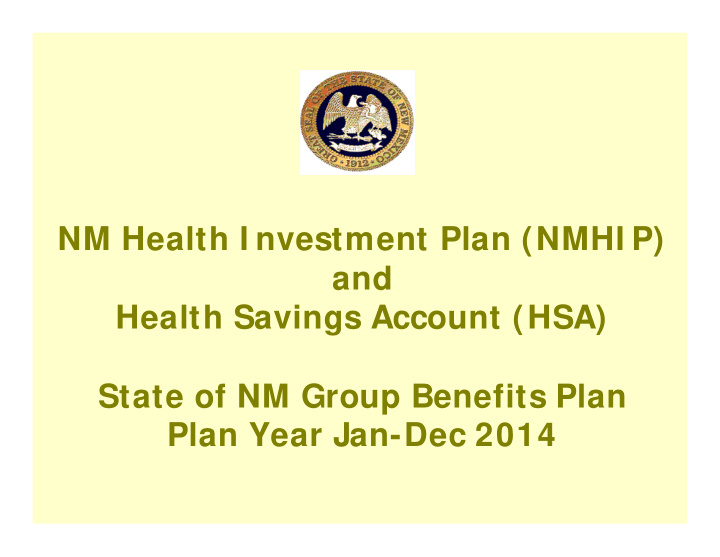



NM Health I nvestment Plan (NMHI P) and Health Savings Account (HSA) State of NM Group Benefits Plan Plan Year Jan-Dec 2014
What is an HSA? • Health Savings Account (HSA) is a tax advantaged, fully portable trust account – Offered to eligible individuals (State of NM employees only) – For the purpose of paying various healthcare-related expenses • HSAs can only be offered in conjunction with a qualified High Deductible Health Plan (HDHP). NMHIP is a qualified plan – As outlined in Section 223 of the Internal Revenue Code 2
Key Benefits • Lower insurance premium than traditional health insurance premiums • You save money on taxes • Flexibility & more control over your own healthcare costs • Both you and your employer can make tax-free deposits into your HSA (if you’re enrolled in NMHIP, are not enrolled in Medicare, and/or not claimed as a dependent on another person’s tax return) • State puts a set amount of money in your HSA to help build up your account for healthcare expenses, deductibles, co-pays, and co-insurance 3
Key Benefits • You can use your HSA for yourself, your spouse, and/or any dependents that you claim on your tax return All the money in your HSA is yours to keep (the State’s • deposits are yours to keep as well) Your money rolls over from year to year ( not “use-it-or- • lose-it” like flexible spending plans) • Your money earns interest , and when your balance is large enough, you can invest it tax-free • You can withdraw your money tax-free any time , as long as it’s for qualified medical expenses 4
Key Benefits Your money goes with you , even if you leave your job, • leave your qualifying health plan, or retire – it can help you cover work/life transitions as an important safety net • Your HSA can be inherited by your survivors • Your preventive care services are covered 100% by your health plan and these costs do NOT come out of your HSA • HSA funds can be used to pay for long-term care premiums • Reimbursements for qualified expenses are very similar to a medical Flexible Spending Account (FSA) 5
Eligibility • Any State employee who meets the following 5 criteria can enroll in an HSA: 1. Employee is enrolled in NMHIP; 2. Employee is not enrolled in another non-HDHP healthcare plan; 3. Employee is not enrolled in an FSA plan (through self, spouse or other family member); 4. Employee is not covered by Medicare; and 5. Employee is not eligible to be claimed as a tax dependent on another person’s tax return 6
General Facts about NMHI P • NMHIP’s design meets the following federal requirements for 2014: Single Deductible: Federal: at least $1,250 (NMHIP is $1,300) Out-of-Pocket: Federal: $6,350 or less (NMHIP is $4,000) Family Deductible: Federal: at least $2,500 (NMHIP is $2,600) Out-of-Pocket: Federal: $12,700 or less (NMHIP is $8,000) • Non-network deductible and out-of-pocket limits are higher for out-of-network services • These deductibles and out-of-pocket levels will be adjusted in future years 7
General Facts about HDHP plans (NMHI P) • All services, including Rx, will be subject to deductible, except services deemed to be preventive • The federal legislation permits an employee and spouse to establish two HSA accounts if both are enrolled as employees and satisfy the eligibility rules, but combined contributions cannot exceed family limit ($6,550 in 2014). Tracking is the responsibility of the employees • HSA contributions by the employee in excess of the single limit require that one or more dependents are covered under his/her plan 8
NMHI P Plan Design (all 3 medical carriers offer this plan) In-Network Out-of-Network Annual Deductible $1,300 single $2,600 single $2,600 family $5,200 family Coinsurance You pay 20% / Plan pays 80% You pay 40% / Plan pays 60% Out-of-pocket maximum $4,000 per person $8,000 per person $8,000 family $16,000 family Deductible and coinsurance Deductible and coinsurance count toward out-of-pocket count toward out-of-pocket maximum maximum Preventive Care Plan pays 100% You pay 40% after Deductible Office Visit You pay 20% after Deductible You pay 40% after Deductible Emergency Room You pay 20% after Deductible You pay 40% after Deductible Urgent Care You pay 20% after Deductible You pay 40% after Deductible Retail Prescriptions After the deductible is met, you pay: Generic 20% Formulary 30% Non Formulary 40% Specialty 15%; up to $250 9
HSA Funding for State Employees • Funding to your account will be made by you (regular payroll deductions) and by the State (on January 1 and July 1) • 2014 HSA funding limits ( combined State and employee) are: – $3,300 for single coverage / $6,550 for family coverage – Individuals age 55 and older can make an annual catch-up contribution of $1,000 • You can change your pledged amount into HSA twice a year: January 1 and July 1, or at the time of a qualifying event • Each of the 3 medical carriers have their own banking partner for Health Savings Accounts (HSA) 10
HSA Funding • The State will contribute the following annual amounts into your HSA if you elect the NMHIP-HSA plan: – $600 for single coverage – $900 for family coverage • The State will contribute 50% of its annual contribution into your HSA account on January 1 and the remaining 50% will be placed in the account on July 1 • Remember that all the money in your HSA is yours to keep (the State’s deposits are yours to keep as well) 11
Uses For Your HSA • Your insurance deductible • Your co-insurance until you reach your out-of-pocket maximum (NMHIP then covers the rest) • Any qualified healthcare expenses that insurance plans might exclude 12
QUESTI ONS Please follow webinar instructions to immediately submit written questions… which will be answered at the end of the session 13
Recommend
More recommend